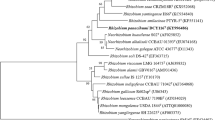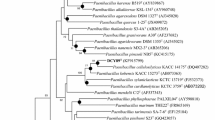Abstract
A novel bacterium, designated DCY114T, was isolated from ginseng-cultivated soil in Gochang-gun, Republic of Korea. This isolate was assigned to the genus Paenibacillus and is closely related to Paenibacillus amylolyticus NRRL NRS-290T (98.3%), P. dongdonensis KUDC0114T (98.0%), P. tylopili MK2T (97.9%), P. tundrae A10bT (97.8%), and P. xylanexedens B22aT (97.5%) based on 16S rRNA gene sequence analysis. Strain DCY114T is a Gram-reaction positive, catalase and oxidase positive, facultatively aerobic rod that is motile by peritrichous flagella. Strain DCY114T produces siderophores and indole-3-acetic acid (IAA) and is able to solubilize phosphate as a plant growth-promoting bacterium. MK-7 was the diagnostic menaquinone. The major cellular fatty acids were anteiso-C15:0, C16:0, and C18:0, and the major polar lipids were diphosphatidylglycerol (DPG), phosphatidylethanolamine (PE), and an unknown amino lipid (AL1,2). The genomic DNA G + C content was 46.0 mol%. Phenotypic and chemotaxonomic results also placed strain DCY114T within the genus Paenibacillus. DNA–DNA homology values between strain DCY114T and closely related reference strains were lower than 43%. The low DNA relatedness data in combination with phylogenetic and biochemical tests indicated that strain DCY114T could not be assigned to a recognized species. The results of this study support that the DCY114T strain is a novel species belonging to the genus Paenibacillus, for which the name Paenibacillus panacihumi is proposed. The type strain is DCY114T (= KCTC 33915T = JCM 32073T).

Similar content being viewed by others
References
Ahemad M, Kibret M (2014) Mechanisms and applications of plant growth promoting rhizobacteria: current perspective. J King Saud Univ Sci 26(1):1–20
Ash C, Priest FG, Collins MD (1993) Molecular identification of rRNA group 3 bacilli (Ash, Farrow, Wallbanks and Collins) using a PCR probe test. Antonie Van Leeuwenhoek 64:253–260
Bauer A, Kirby W, Sherris JC, Turck M (1966) Antibiotic susceptibility testing by a standardized single disk method. Am J Clin Pathol 45:493–496
Choi KT (2008) Botanical characteristics, pharmacological effects and medicinal components of Korean Panax ginseng CA Meyer. Acta Pharmacol Sin 29:1109–1118
Díaz-Zorita M, Fernández-Canigia MV (2009) Field performance of a liquid formulation of Azospirillum brasilense on dryland wheat productivity. Eur J Soil Biol 45:3–11
Ezaki T, Hashimoto Y, Yabuuchi E (1989) Fluorometric deoxyribonucleic acid-deoxyribonucleic acid hybridization in microdilution wells as an alternative to membrane filter hybridization in which radioisotopes are used to determine genetic relatedness among bacterial strains. Int J Syst Evol Microbiol 39:224–229
Felsenstein J (1981) Evolutionary trees from DNA sequences: a maximum likelihood approach. J Mol Evol 17:368–376
Felsenstein J (1985) Confidence limits on phylogenies: an approach using the bootstrap. Evolution 39:783–791
Fitch WM (1971) Toward defining the course of evolution: minimum change for a specific tree topology. Syst Biol 20:406–416
Hall TA (1999) BioEdit: a user-friendly biological sequence alignment editor and analysis program for Windows 95/98/NT. Nucleic Acids Symp Ser 41:95–98
Hiraishi A, Ueda Y, Ishihara J, Mori T (1996) Comparative lipoquinone analysis of influent sewage and activated sludge by high-performance liquid chromatography and photodiode array detection. J Gen Appl Microbiol 42:457–469
Kim MK, Kim YA, Park MJ, Yang DC (2008) Paenibacillus ginsengihumi sp. nov., a bacterium isolated from soil in a ginseng field. Int J Syst Evol Microbiol 58:1164–1168
Kim OS et al (2012) Introducing EzTaxon-e: a prokaryotic 16S rRNA gene sequence database with phylotypes that represent uncultured species. Int J Syst Evol Microbiol 62:716–721
Komagata K, Suzuki KI (1988) 4 Lipid and cell-wall analysis in bacterial systematics. Methods Microbiol 19:161–207
Lane D (1991) 16S/23S rRNA sequencing. In: Stackebrandt E, Goodfellow M (eds) Nucleic acid techniques in bacterial systematics. Wiley, Chichester, pp 115–176
Levine M, Epstein S, Vaughn R (1934) Differential reactions in the colon group of bacteria. Am J Public Health Nations Health 24:505–510
Mesbah NM, Whitman WB, Mesbah M (2011) 14-determination of the G + C content of prokaryotes. Methods Microbiol 38:299–324
Minnikin D, O’donnell A, Goodfellow M, Alderson G, Athalye M, Schaal A, Parlett J (1984) An integrated procedure for the extraction of bacterial isoprenoid quinones and polar lipids. J Microbiol Methods 2:233–241
Nguyen NL, Kim YJ, Hoang VA, Kang JP, Singh P, Yang DC (2015) Paenibacillus panaciterrae sp. nov., isolated from ginseng cultivated soil. Int J Syst Evol Microbiol 65:4080–4086
Pikovskaya R (1948) Mobilization of phosphorus in soil in connection with vital activity of some microbial species. Mikrobiologiya 17:362–370
Prescott L, Harley J (2001) Endospore staining. Laboratory exercises in microbiology, 5th edn. McGraw-Hill, New York, pp 61–62
Saitou N, Nei M (1987) The neighbor-joining method: a new method for reconstructing phylogenetic trees. Mol Biol Evol 4:406–425
Sasser M (1990) Identification of bacteria by gas chromatography of cellular fatty acids, MIDI Technical Note 101. MIDI Inc., Newark
Schumann P (2011) 5-Peptidoglycan structure. Methods Microbiol 38:101–129
Schwyn B, Neilands J (1987) Universal chemical assay for the detection and determination of siderophores. Anal biochem 160:47–56
Shida O, Takagi H, Kadowaki K, Nakamura LK, Komagata K (1997) Transfer of Bacillus alginolyticus, Bacillus chondroitinus, Bacillus curdlanolyticus, Bacillus glucanolyticus, Bacillus kobensis, and Bacillus thiaminolyticus to the genus Paenibacillus and emended description of the genus Paenibacillus. Int J Syst Bacteriol 47:289–298
Shokri D, Emtiazi G (2010) Indole-3-acetic acid (IAA) production in symbiotic and non-symbiotic nitrogen-fixing bacteria and its optimization by Taguchi design. Curr Microbiol 61:217–225
Sukweenadhi J, Kim YJ, Lee KJ, Koh SC, Hoang VA, Nguyen NL, Yang DC (2014) Paenibacillus yonginensis sp. nov., a potential plant growth promoting bacterium isolated from humus soil of Yongin forest. Antonie Van Leeuwenhoek 106:935–945
Tamura K, Stecher G, Peterson D, Filipski A, Kumar S (2013) MEGA6: molecular evolutionary genetics analysis version 6.0. Mol Biol Evol 30:2725–2729
Ten LN, Baek SH, Im WT, Lee M, Oh HW, Lee ST (2006) Paenibacillus panacisoli sp. nov., a xylanolytic bacterium isolated from soil in a ginseng field in South Korea. Int J Syst Evol Microbiol 56:2677–2681
Thompson JD, Gibson TJ, Plewniak F, Jeanmougin F, Higgins DG (1997) The CLUSTAL_X windows interface: flexible strategies for multiple sequence alignment aided by quality analysis tools. Nucleic Acids Res 25:4876–4882
Vaz-Moreira I, Faria C, Nobre MF, Schumann P, Nunes OC, Manaia CM (2007) Paenibacillus humicus sp. nov., isolated from poultry litter compost. Int J Syst Evol Microbiol 57:2267–2271
Weisburg WG, Barns SM, Pelletier DA, Lane DJ (1991) 16S ribosomal DNA amplification for phylogenetic study. J Bacteriol 173:697–703
Yoon MH, Ten LN, Im WT (2007) Paenibacillus ginsengarvi sp. nov., isolated from soil from ginseng cultivation. Int J Syst Evol Microbiol 57:1810–1814
Acknowledgements
This study was supported by a Grant from the Korea Institute of Planning & Evaluation for Technology in Food, Agriculture, Forestry & Fisheries (KIPET NO: 317007-3), Republic of Korea.
Author information
Authors and Affiliations
Corresponding authors
Additional information
Communicated by Erko Stackebrandt.
The NCBI GenBank accession number for the 16S rRNA gene sequence of strain DCY114T is KY694399. DPD (digital protologue’ database) Taxon number: TA00398.
Electronic supplementary material
Below is the link to the electronic supplementary material.
Rights and permissions
About this article
Cite this article
Kim, CG., Kang, JP., Huo, Y. et al. Paenibacillus panacihumi sp. nov., a potential plant growth-promoting bacterium isolated from ginseng-cultivated soil. Arch Microbiol 200, 1049–1055 (2018). https://doi.org/10.1007/s00203-018-1517-z
Received:
Revised:
Accepted:
Published:
Issue Date:
DOI: https://doi.org/10.1007/s00203-018-1517-z




